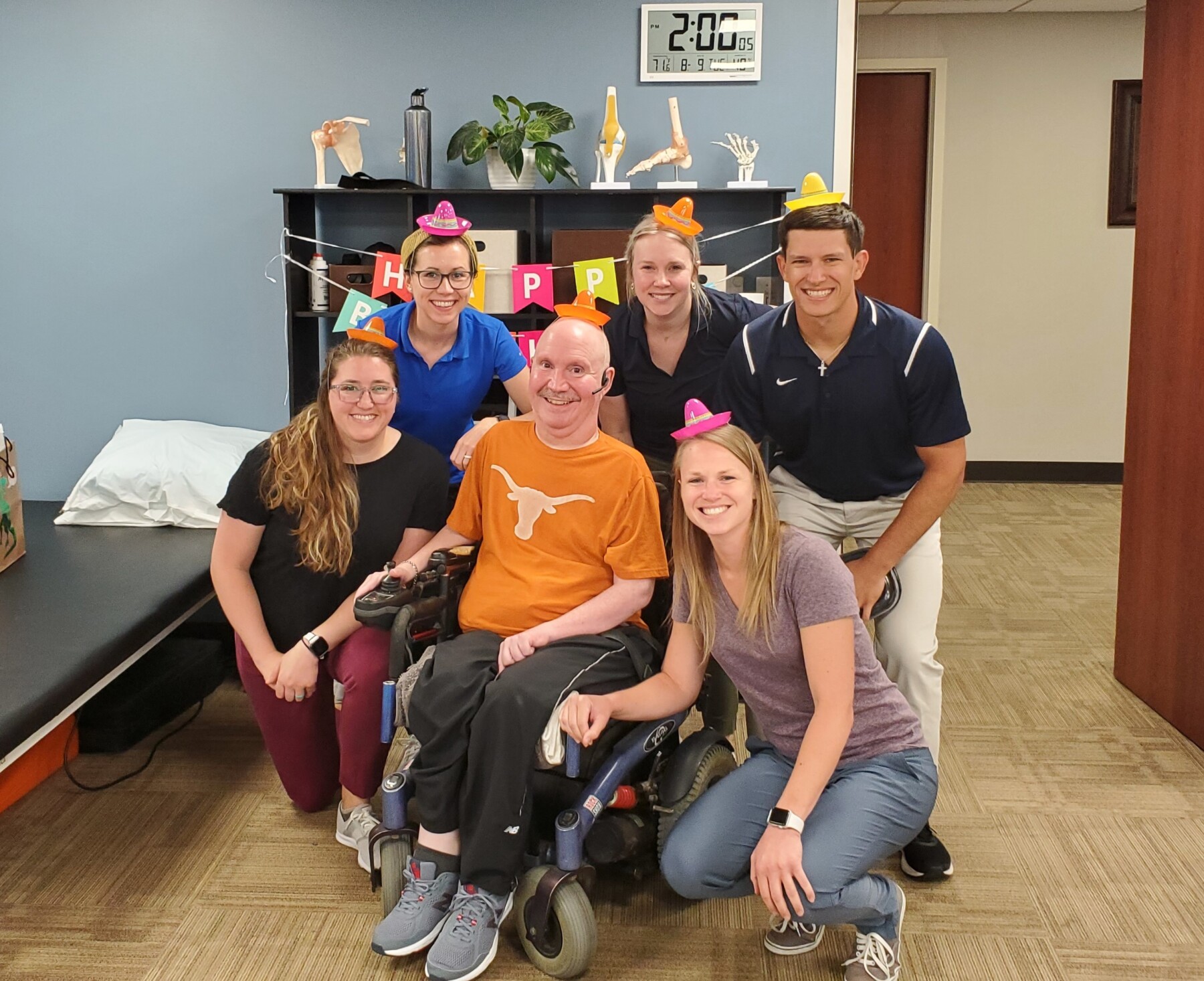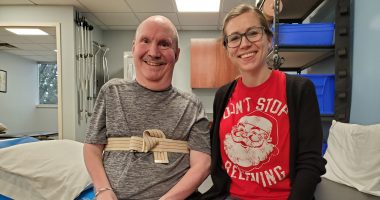Aligning physical therapy goals ahead of possible FDA approval
Therapist, patient eagerly await potential approval of apitegromab

Michael Morales poses on his birthday with the physical therapy team he works with. (Photo courtesy of Michael Morale)
Over the past seven years, I’ve been working with a patient, Michael, who has spinal muscular atrophy (SMA), toward many different goals.
If we’re being honest, we have been experimenting on how to reach those goals since there is a lot unknown around physical therapy and SMA. While most of these goals have been to improve Michael’s comfort while he sits in his wheelchair throughout the day, we may soon be working toward improving function.
As of now, the only SMA treatment Michael is taking is Spinraza (nusinersen) every four months. Spinraza is used to help the body produce more of a protein that is needed for the motor neurons to function correctly and prevent or decrease further muscle weakness and wasting. With this treatment, we have been focusing on attempting to minimize the amount of muscle and bone atrophy that’s common among SMA patients.
We spend a good amount of time on stretching and elongating muscles in his legs and stabilizing his core. In the near future, we are hoping Scholar Rock will get Food and Drug Administration approval for apitegromab, and we will be able to change our focus while he is on a combination treatment with Spinraza.
Apitegromab targets the latent form of myostatin, which is known to be a growth inhibitor and keeps patients with SMA from developing muscle strength and muscle mass. By addressing the myostatin in Michael’s body, our hopes and prayers will be to start by strengthening certain muscle groups.
We’ve discussed starting by targeting biceps and triceps, along with wrist, hand, and finger strength. Starting with smaller muscle groups, we may be able to see some change faster. Getting some strength in these muscles will improve Michael’s ability to perform fine motor tasks and use his wheelchair joystick with increased ease. If successful, this will also help Michael feel as if he is less dependent on others to perform certain daily tasks.
We will use neuromuscular electrical stimulation to help stimulate specific muscle groups, which will increase the recruitment of the muscles. We will also target the muscles on the back of his legs that pump his foot up and down. This will be a good group to treat with electrical stimulation and get some increased muscle activation.
As we work through getting muscle activation, as we are able, we will use resistance bands for strengthening in the various ranges. Dry needling and shockwave therapy will also be used as needed throughout the new combination therapy of Spinraza and apitegromab.
Patient perspective
Spinraza was never designed to be a one-treatment miracle; the purpose of Spinraza was to slow or stop the progression of this hideous disease. Many people with SMA reported they are no longer getting worse, while others, like myself, are still getting weaker, but not as quickly as we used to. In my prayers at night, I give thanks Spinraza has given many of us with SMA a better and more productive life.
With the potential of apitegromab receiving FDA approval this year, SMA patients are seeing that proverbial light at the end of the tunnel. The potential combination therapy of Spinraza and apitegromab will give us a treatment that will address not only the cellular level of our disease, but also the muscle level as well. We may finally have a treatment that will allow us to build muscle mass and muscle strength, and give us the ability to target certain muscle groups. When this combination therapy becomes a reality, our excitement levels will be heightened to a level we’ve never before seen.
Emily and I have spoken about our future goals regarding my physical therapy, and as excited as I am, I also see a level of excitement in Emily’s eyes, and this gives me a great deal of satisfaction. She’s worked so hard, along with other therapists on my care team, and I’m just as excited for her as I am for myself. We are both going into this potential combination therapy with open eyes. Emily and I are praying for little victories, because enough little victories will eventually add up to answered prayers.

